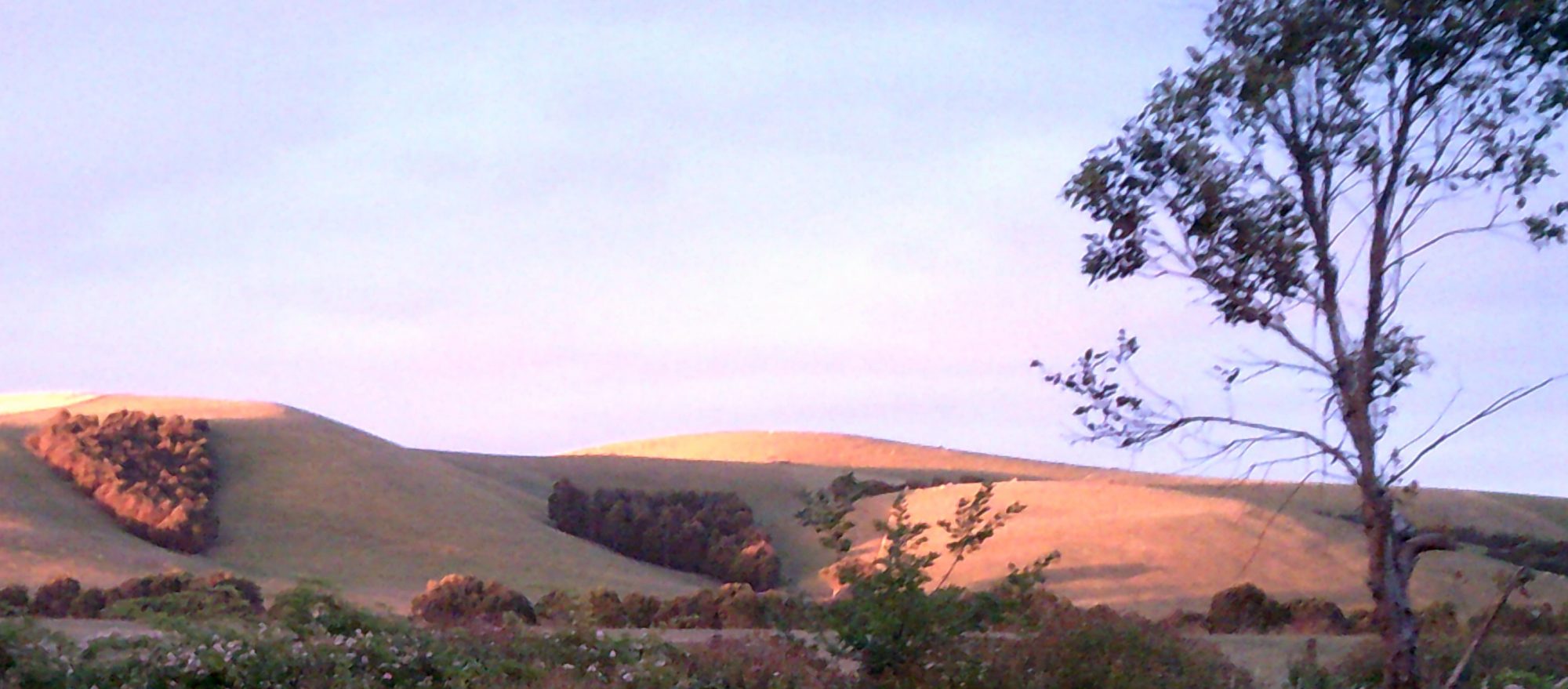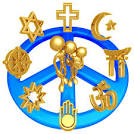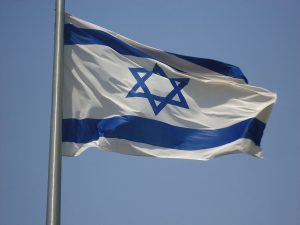A few years ago, I held an exhibition of my paintings at a Jewish Arts Centre in Melbourne. The exhibition was based on an important historical and theological concept in Judaism named Tikkun Olam (Heal the World). During the recent Israeli attacks on Gaza, I was reminded of the two fundamental teachings in Judaism that most Jews today still adhere to without question. On the one hand, Tikkun Olam, or the obligation to heal the world and on the other the State of Israel, or the designated Jewish homeland. These two critical imperatives dominate Jewish life, but they are also buried in a complex mythology which raises obvious contradictions. How does one heal the world while at the same time a war is being raged against people who disagree with the Jewish interpretation of history?
More than 2000 years lapsed between the Jewish Diaspora and the re-birthing of Israel. There were very few Jews left in the homeland after the mass exodus, but they suddenly arrived in droves in 1948 and in a slow trickle before then. This has led to numerous questions about the role of the Jewish State in modern global politics and whether there has been a deliberate attempt to eliminate the Palestinian population or to assimilate them into one bilateral territory. Israel would not have survived without the backing of the United States, whose leaders saw a strategic advantage in having an ally sitting between east and west. At the end of the Second World War, the establishment of Israel was viewed as a solution for Jews who were homeless following the horrors of the Holocaust, it was also of strategic importance. Israel has moved ahead exponentially since then and has claimed significantly more territory, while Palestinians have been constantly driven into poverty, oppression and persecution. It begs the question: Was partition a genuine attempt to house desperate and suffering Jews? Or was there another agenda before that?
Undoubtedly, Jewish history is modelled on trauma, but instead of looking retrospectively to deal with the internal pain, many have turned it outwards and created a nationalist and eschatological explanation for decades of conflict and Human Rights abuses. Throughout history Jews have suffered for their beliefs, but they have also brought immeasurable suffering upon themselves. In 1948 the nation that once was Palestine was partitioned, which resulted in the creation of the Jewish State of Israel, but sadly, Israel is not a land of emancipation, but one of exclusivity, insecurity and wars. Israel is a small fortress surrounded by hostile enemies. Is this the Jewish dream or the reality of a horrible nightmare?
The Conflicts.
Two main conflicts took place in 1947 and 1948, the Civil War in Mandatory Palestine and the Arab–Israeli conflict in 1948, but the story that gave rise to these conflicts is much older.
Well before partition a nationalist state for the Jews was already in the planning. The Mandate on Palestine and the conflicts between Palestinian Arabs and Jewish Zionists are well documented, but the events that took place before partition and leading up to the conflict are less known. There was seemingly a plot to eliminate Palestine well before partition. The plot was hatched with the establishment of modern Zionism in Eastern Europe.
Modern Zionism emerged in the context of modern Antisemitism in the late 19th century. It started in Central and Eastern Europe as a nationalist revival movement and as a reaction to the rise in Antisemitism. It was also a response to the Haskalah, or the Jewish Enlightenment. The Jewish Enlightenment was not a lot different to similar movements around the western world. Modern industrialisation had driven many rural people off the land and into cities and factories. Feudalism was being dismantled and a capitalist system was replacing it. Workers received a wage, but it was a poor reward for mass slavery. Importantly, at an intellectual level, the old superstitions and beliefs were being replaced with scientific explanations.
The Haskalah means wisdom and the new knowledge and wisdom among Jews was to be expressed in a burgeoning intellectual movement among the Jews of Central and Eastern Europe who called themselves Zionists.
Zionism differed from other forms of Enlightenment in that it held on to the old traditions, but it also followed the Enlightenment methodology that led to a vast wave of imperialism, territorial expansion and colonialism. During the 1770s to about 1881 Zionism was an ideological worldview that had its roots in Jewish nationalism. This followed the rise of nationalism in England, France, parts of Eastern Europe and the United States. With many nations in the grip of a new nationalism the Zionist movement felt to challenge the Ottoman Empire and lay claim to Palestine as the national home of the Jewish people. The target was the whole of Palestine and the displacement of the Arabic population.
The Promised Land.
According to the Bible and Judaism, Eretz Israel was promised to the Jews by God. Based on this promise, in 1854, an American businessman named Judah Touro bequeathed money to fund Jewish residential settlements in Palestine. The executor of the Will was Sir Moses Montefiore (1784 -1885). Montefiore was a British financier, banker, philanthropist and a Sheriff of London. Montefiore was from a rich Italian-Jewish family and he used his wealth to promote economic development among Jewish communities in the Levant, but he is best known for his contribution to education and the Montefiore schools. He founded the Mishkenot Sha’ananim in 1860, a Jewish residential settlement and almshouse outside of the old walled city of Jerusalem; the first settlement outside Jerusalem’s walled city. As President of the Board of Deputies of British Jews, Montefiore carried a lot of influence with the British consul in Damascus. The consul Charles Henry Churchill (1841–42) is viewed as pivotal to the development of the new Zionism. 1 Many of the Montefiore funds were used for transporting Jews to Palestine.
In 1812, Moses Montefiore married Judith Cohen (1784–1862). Judith’s sister married Nathan Mayer Rothschild (1777–1836) and Montefiore’s firm acted as stockbrokers for the Rothschild’s family business. The two brothers-in-law became business partners. They invested in major projects like gas and insurance. In 1824 Montefiore was among the founding consortium of the Alliance Life Assurance Company (which later merged with Sun Insurance to form Sun Alliance 2
Pogroms.
Between 1881-1884 a mass persecution of Jews took place in the Russian Empire (the pogroms). In 1882, a group of Hovevei Zion members founded Rishon LeZion, the first Zionist settlement in the Land of Israel. It was led by philanthropist Isaac Leib Goldberg. The Zionists got around the political obstacles by registering as a charity. In 1890 The Society for the Support of Jewish Farmers and Artisans in Syria and Eretz Israel came into existence. It was later known as the Odessa Committee. The Odessa Committee was dedicated to the practical aspects in establishing agricultural settlements. One of the major donors was the tea merchant, Kalonimus Wolf Wissotzky (1884-18850, who founded the largest tea company in Russia, Wissotzky Tea. Wissotzky financed agricultural colonies in Palestine. 3
Theodor Herzl
Zionism as an organised movement is generally considered to have been founded by Theodor Herzl in 1897. However, as we have noted, the history of Zionism began earlier and is related to the pogroms. The Hovevei Zion, or the Lovers of Zion, were responsible for the creation of 20 new Jewish cities in Palestine between 1870 and 1897. 4 In 1850, Palestine had about 350,000 inhabitants. Roughly 85% were Muslims, 11% were Christians and 4% were Jews. 5 Upon the outbreak of World War I, political Zionism reasserted itself, and its leadership passed to Russian Jews living in England. Two such Zionists, Chaim Weizmann and Nahum Sokolow, were instrumental in obtaining the Balfour Declaration from Great Britain’s Jews. The failure of the Russian Revolution of 1905 and the wave of pogroms and repressions that followed caused growing numbers of Russian Jewish youth to emigrate to Palestine as pioneer settlers. By 1914 there were about 90,000 Jews in Palestine; 13,000 settlers lived in 43 Jewish agricultural settlements, many of them supported by the French Jewish philanthropist Baron Edmond de Rothschild. The Hovevei Zion, are now considered the forerunners of modern Zionism.
Since the creation of Israel, the country has grown stronger and the importance of the Zionist movement as an organisation has split into factions.
It was the Zionists who had laid the foundations for Arab suppression. It was a deliberate attempt to eliminate the Palestinians and steal back the land. In Jewish circles, Zionism is not talked about in these terms. There are Jews who oppose Zionism, but there are also those who make no division between being a Jew and being a Zionist.
The success of Zionism has meant that the percentage of the world’s Jewish population who live in Israel has steadily grown over the years and today 40% of the world’s Jews live in Israel. The second largest population of Jews reside in the US.
A political opportunity was given to Zionism when Theodor Herzl asserted assimilation as the most desirable remedy for the Jews, but he knew it would never work. He argued that Jews were forced by the external pressure of Antisemitism to form a nation. In a sense this was true, after World War ll, no one wanted a host of displaced Jews. Added to this, there was an immense nationalist push across the western world as the boundaries shifted. A Jewish State was therefore convenient, it would have its uses.
In 1897 Herzl convened the first Zionist Congress at Basel, Switzerland, which drew up the Basel program of the movement, stating that “Zionism strives to create for the Jewish people a home in Palestine secured by public law.”
The centre of the movement was established in Vienna, where Herzl published the official weekly Die Welt (“The World”). Zionist congresses met yearly until 1901 and then every two years. When the Ottoman government refused Herzl’s request for Palestinian autonomy, he found support in Great Britain. In 1903 the British government offered 6,000 square miles (15,500 square km) of uninhabited Uganda for settlement, but the Zionists wanted Palestine.6
At the death of Herzl in 1904, the leadership moved from Vienna to Cologne and then to Berlin. Prior to World War I, Zionism represented only a very small number of Jews, mostly from Russia, but led by Austrians and Germans. By 1933 Jewish immigration remained relatively slow, until the rise of Hitler in Europe. The Arabs anticipated trouble and feared that Palestine would eventually become a Jewish state so they resisted Zionism and the British government that was known to have Zionists as members. British forces struggled to maintain order in the face of a series of Arab uprisings. The strain of suppressing the Arab revolt of 1936–39, ultimately forced Britain to reassess its hold on Palestine. In hopes of keeping the peace between Jews and Palestinian Arabs and retaining Arab support against Germany and Italy in World War II, Britain placed restrictions on Jewish immigration in 1939. The new restrictions were violently opposed by Zionist groups such as the Stern Gang and Irgun Zvai Leumi, which committed acts of terrorism and assassination against the British. They also organised illegal Jewish immigration to Palestine.7
Following the mass extermination of Jews by Hitler many surviving Jews sought refuge in Palestine and the United States. Zionism achieved its aim of establishing a Jewish State in Palestine, but at the same time, it became an armed stronghold surrounded by hostility and it has impacted on the security of much of the western and middle eastern world.
Israel is still iconic in Jewish history, philosophy and the lived experience. Zionist organisations in many countries continue to raise financial support for Israel and to encourage Jews to immigrate there. Jews have been raised to see Israel as central to their existence. Many Jews have been led to believe they are living their lives in exile and they need to relocate to the homeland. The psychological damage of not belonging is immense and Israel has exacerbated this by not accepting many of its own people. Qualifying as a Jew is predicated on the burden of proof and it can never be neutral.
The Six Day War.
On 14 May 1948, in accordance with the UN resolution, partition enabled Israel to become a nation state for the Jewish people. Zionism had, in part, fulfilled its objectives. As a result, many Zionist institutions became government institutions and the three Zionist militias were combined to form the Israeli Defence Forces.
The 1967 the Six Day War between Israel and the Arab states marked a major turning point in the history of both Israel and of Zionism. Israeli forces captured the eastern half of Jerusalem, including the holiest of Jewish religious sites, the Western Wall of the ancient Temple. They also took over the remaining territories of pre-1948 Palestine, the West Bank (from Jordan) the Gaza Strip (from Egypt) as well as the Golan Heights (from Syria). As Israel grew stronger Arab nationalism was also growing with demands that Palestine become an Arab state and hostility continues to escalate as the wounds of 1948 are still remembered and relived.
Ethnic Cleansing.
In a book called The Ethnic Cleansing of Palestine authored by the Historian Ilan Pappé and published in 2006, the writer claims that in the 1948 Palestinian war around 720,000 Palestinian Arabs out of the 900,000 who lived in the territories that became Israel, fled or were expelled from their homes. In his own words, Ilan Pappé makes the case for the paradigm of ethnic cleansing and use[s] it to replace the paradigm of the war in 1948. 8 Pappé argues that the forced removal of Palestinians to the Arab world was a long-time objective of the Zionist movement. We now know this to be fact.
According to Pappé, the 1948 Palestinian exodus resulted from a planned ethnic cleansing of Palestine that was implemented by the Zionist movement leaders, mainly David Ben-Gurion and the other ten members of his consultant committee. It was called Plan Dalat and it was aimed at the expulsion of 500 Arab villages.
Dalet is the fourth letter of the Hebrew alphabet, the word Dalet means door, the door stands as the opening of the house the beit. Among Orthodox Jews who read the Zohar Dalet is the awareness of one’s own power and the power to achieve success, but that power also depends on Divine aid. The Jewish Talmud describes a story where one man is carrying a heavy object and another man comes to help him by placing his hands under the object, but in reality, the help is just an appearance, the first man is still carrying the weight.9 The weight of war and oppression has been carried by the Zionists and this is still the case today. It is true to say that the Palestinians launch rockets across the border and that they are a cause of great annoyance, but these are not high-powered weapons we are talking about, they a backyard experiments which are no match for Israel’s defence system. Palestine has no army, it has no tanks or sophisticated weapons, no fighter jets or battleships. The border skirmishes consist of children, teenagers and a few adults throwing rocks at Israeli personnel. In retaliation Israeli soldiers shoot to maim or kill.
In 2021 where are we now? Israel pounded Gaza with bombs and heavy artillery for 11 days where at least 243 people, including more than 100 women and children, were killed. According to its health ministry, Israel has said it killed 225 militants.
Israel has always claimed its 1967 land conquests were not planned. According to Haaretz, Declassified Documents Reveal Otherwise.10
- 1Adler, Joseph (1997). Restoring the Jews to their homeland: nineteen centuries in the quest for Zion. J. Aronson. pp. 150–6. ISBN1-56821-978-4. Retrieved 19 January 2011.
- Wolf, Lucien (1919). “Notes on the Diplomatic History of the Jewish Question with texts of protocols, treaty stipulations and other public acts and official documents”. The Jewish Historical Society of England.[permanent dead link]
- Levine, Menachem. “Sir Moses Montefiore – A Brief History”. Aish. Retrieved 12 December 2018.
- 2“Records of Sun Fire Office”. UK National Archives. Retrieved 19 April 2020. and wikipedia Moses Montefore https://en.wikipedia.org/wiki/Moses_Montefiore Retrieved 2nd June 2021.
3Pioneers of Zionism: Hess, Pinsker, Rülf, Julius H. Schoeps
4 Penslar, Derek Jonathan (1991). Zionism and Technocracy: The Engineering of Jewish Settlement in Palestine, 1870-1918. Indiana University Press. pp. 20–. ISBN 0-253-34290-2. Hovevei Zion, the name attached to an informal network of Jewish nationalist societies that sprang up in the wake of the 1881 pogroms and which was officially constituted in 1884
5 Scholch, Alexander (November 1985). “The Demographic Development of Palestine, 1850-1882”. International Journal of Middle East Studies. Cambridge University Press. 17 (4): 485–505. doi:10.1017/S0020743800029445. JSTOR 163415.
6https://www.britannica.com/topic/Zionism
7Ibid
- 8 Ilan Pappé (2006). Preface xxvii The Ethnic Cleansing of Palestine, Oneworld Oxford.
9Rabbi Yitzchak Ginsburgh. 1990 Dalet in the Hebrew Letters: Channels of Creative Consciousness. Jerusalem Gal Einai Publictions p66
10Haaretz 4th June 2021. https://www.haaretz.com/israel-news/.premium-israel-said-67-land-conquests-weren-t-planned-declassified-documents-say-otherwise-1.9873297?fbclid=IwAR1LvPodYwJwIXo2aMQrpiPhna8b_zKn2eI1zFqaT5FEPDSMY80k-pT9Gx4 Retrieved 4th June 2021.



